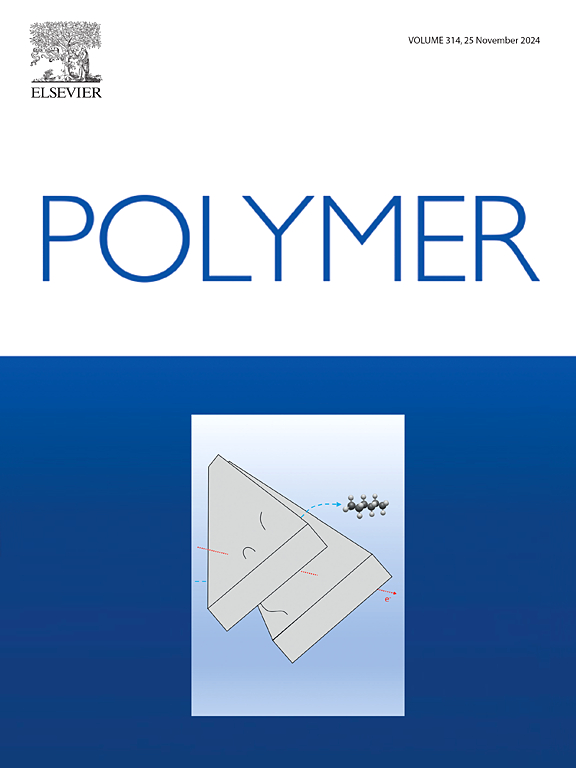Integration of B-N Coordinated Boronic Ester Bonds into Epoxy Networks Through One-step Crosslinking
IF 4.1
2区 化学
Q2 POLYMER SCIENCE
引用次数: 0
Abstract
Epoxy vitrimers containing boron-nitrogen (B-N) coordinated boronic ester and/or boroxine bonds were obtained with a one-step curing reaction. Toward this end, diepoxide (i.e., diglycidyl ether of 1,4-butanediol) was crosslinked with an aromatic amine bearing boronic acid group (e.g., 3-aminobenzeneboronic acid) as the crosslinker. The crosslinking was accomplished through the following in situ reactions. First, the ring-opening polyaddition of epoxide with primary amino groups afforded a linear poly(hydroxyl ether amine). Second, the reaction of di(2-hydroxyethyl)amino structural units of the linear poly(hydroxyl ether amine) with boronic acid groups led to the crosslinking. To reinforce the epoxy networks, a POSS diepoxide [viz. 3,13-diglycidyl double decker silsesquioxane, DDSQ] was further introduced to prompt the co-crosslinking. It was demonstrated that in the epoxy vitrimers the crosslinking was accounted for: i) the inter-chain dynamic covalent bonds and ii) the inter-chains POSS-POSS aggregation. Benefiting from the exchange of dynamic covalent bonds, the epoxy networks displayed excellent reprocessing (or recycling) properties. Thanks to the generation of POSS nanodomains, the epoxy networks were significantly reinforced. It was found that the thermomechanical properties of epoxy networks can be modulated by taking control of the crosslinking densities of the epoxy networks. In the meantime, the epoxy networks showcased the excellent shape memory properties featuring the reconfigurability. Thanks to the introduction of the organosilicon component (i.e., POSS), the improved surface hydrophobicity was displayed, which is pivotal to the epoxy networks against hydrolysis of boronic ester bonds.

通过一步交联将B-N配位硼酯键集成到环氧网络中
采用一步固化反应制备了含硼氮(B-N)配位硼酯和/或硼辛键的环氧玻璃体。为此,二氧化物(即1,4-丁二醇二甘油酯醚)与含硼酸基团(如3-氨基苯硼酸)的芳香胺交联。交联是通过以下原位反应完成的。首先,环氧化物与伯胺基开环聚加成得到线性聚羟基醚胺。其次,线性聚(羟基醚胺)的二(2-羟乙基)氨基结构单元与硼酸基团反应导致交联。为了加强环氧网络,进一步引入POSS二氧化物[即3,13-二缩水甘油酯双层硅氧烷,DDSQ]来促进共交联。结果表明,环氧玻璃体的交联主要是:1)链间动态共价键和2)链间POSS-POSS聚集。得益于动态共价键的交换,环氧树脂网络表现出优异的后处理(或回收)性能。由于POSS纳米结构域的产生,环氧树脂网络得到了显著的增强。研究发现,通过控制环氧树脂网络的交联密度,可以调节环氧树脂网络的热机械性能。同时,环氧树脂网络具有优异的形状记忆性能,具有可重构性。由于有机硅组分(即POSS)的引入,表面疏水性得到了改善,这是防止硼酯键水解的环氧网络的关键。
本文章由计算机程序翻译,如有差异,请以英文原文为准。
求助全文
约1分钟内获得全文
求助全文
来源期刊

Polymer
化学-高分子科学
CiteScore
7.90
自引率
8.70%
发文量
959
审稿时长
32 days
期刊介绍:
Polymer is an interdisciplinary journal dedicated to publishing innovative and significant advances in Polymer Physics, Chemistry and Technology. We welcome submissions on polymer hybrids, nanocomposites, characterisation and self-assembly. Polymer also publishes work on the technological application of polymers in energy and optoelectronics.
The main scope is covered but not limited to the following core areas:
Polymer Materials
Nanocomposites and hybrid nanomaterials
Polymer blends, films, fibres, networks and porous materials
Physical Characterization
Characterisation, modelling and simulation* of molecular and materials properties in bulk, solution, and thin films
Polymer Engineering
Advanced multiscale processing methods
Polymer Synthesis, Modification and Self-assembly
Including designer polymer architectures, mechanisms and kinetics, and supramolecular polymerization
Technological Applications
Polymers for energy generation and storage
Polymer membranes for separation technology
Polymers for opto- and microelectronics.
 求助内容:
求助内容: 应助结果提醒方式:
应助结果提醒方式:


